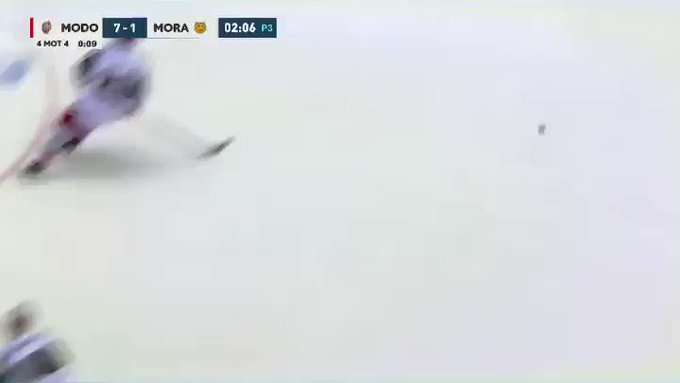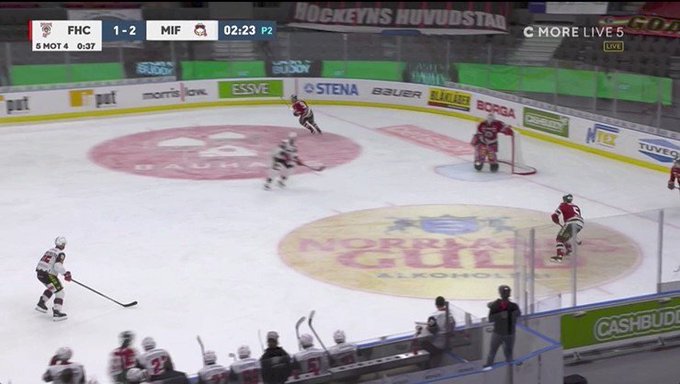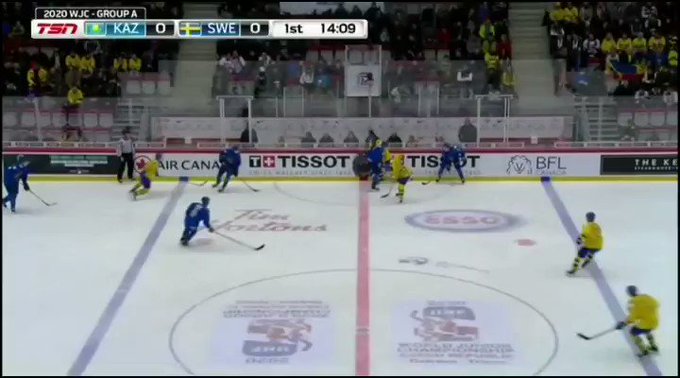Heading into the 2019 NHL Draft, the Montreal Canadiens’ scouting staff were conscious of the team’s glaring need for defensive support on the left side, especially with their bet on Karl Alzner failing; the blueliner was sent to the American Hockey League (AHL) before the end of 2018 due to poor performances in his nine games of the season and still had four years left on his $4.625 million contract.
The scouting team followed suit, selecting five left-handed blueliners with their 10 picks of the draft, including Mattias Norlinder in the third round. The pick was initially seen as a reach at 64th overall, especially since over-agers usually tend to get drafted in the fourth to seventh rounds, but Norlinder has since shown that his point totals were hiding the profile of a smart offensive defenseman with an outstanding skating stride and a great sense for the game. Using footage, analysis and data, we will evaluate in detail what he could bring to the table at the next level, especially after just recently signing his entry-level contract with the Canadiens.
Norlinder’s post-draft seasons were great indicators of what was to come for him, as he immediately earned the Best Junior Player award in Sweden’s second division of men’s hockey in 2019-20, and he followed up with a decent Swedish Hockey League (SHL) showing with 10 points in 37 games. He improved as the season went on, and he brought his game up a notch in the playoffs with five points in seven games.
Strengths
To begin Norlinder’s breakdown, we will use footage to look at his game in more detail and point out the attributes that stand out the most.
Puck Skills – Retrievals, Receptions and Dekes
Norlinder’s ability to take any puck, good or bad, and rid himself of the first wave of forechecking to free up space and teammates is truly mesmerizing to watch. Whether he is receiving a pass on his tape, near his skates, farther from his body, in-stride, on his forehand or his backhand, and especially when grabbing dump-ins behind his goaltender, Norlinder will recover the puck, make a quick move, and start the breakout swiftly. His ability to receive and deke in one motion while moving his feet is especially visible in the offensive zone, as the prospect has scored more than his share of highlight-reel goals for a defenseman.
His ability to control his pace and arrive into pockets of open ice with the right speed differential to beat defenders makes him a lethal threat as a fourth forward on the rush, and he can dangle through forecheckers when breaking out himself with a lot of efficiency. He carries the puck in his hip pocket, ready to either pass or deke in the same motion based on what’s ahead of him. He needs no time at all to move the puck around or through opponents and excels in small-ice situations. There’s always a risk involved with puck-carrying defensemen who like to dangle through pressure, and Norlinder can occasionally commit a mistake when carrying the puck up-ice, but in general, his attempts tend to succeed.
Passing – Vision, Accuracy and Purpose
Norlinder’s passing adds a layer of threat to his rushing game, as he will often look off his pass and hit an open forward in stride; he uses that constant passing threat to open up more deking opportunities, as it forces forwards to respect other options. He can find seams very well and can pass through opponents efficiently. The word that comes to mind when watching Norlinder distribute the puck is “purpose.” He doesn’t pass the problem to someone else; instead, he scans the play and passes to a player who is either going faster than him or a player who is in an open position to make a better play. There’s a purpose to each pass he makes, and it results in better and quicker offense for his team.
His aggressive mindset on breakouts puts an even bigger spotlight on his distributing skills, as he will often get involved in the final third and use his vision to locate threats as they open up. He quarterbacks the power play with poise and control, offering a pressure release for the half-wall options and distributing the puck east-west efficiently to change the point of attack. He is surgical and precise in his approach to the power-play game, often using his one-touch playing ability to break through seams and create movement all over the ice.
Hockey IQ – Processing Speed, Anticipation and Problem-Solving
Norlinder is at his best when he is aware and dialed in, which he maximizes by scanning the ice consistently, no matter where he is. When he is recovering the puck behind his own net, he can be seen checking behind him four or five times to gauge everything from his opponents’ speed while closing down on him to his teammates’ positioning in case he needs them. He takes a moment while preparing to receive a puck in order to locate the best-possible option once he receives it, whether that is a one-touch pass, a quick deke and zone entry, or a shot on goal.
In the first sequence, Norlinder checks his shoulder seven times in a span of about 15 seconds; there are prospects that don’t shoulder-check that often in an entire game. He does this while keeping his focus on the puck’s trajectory, reading the play and making the right decisions to maximize the team’s chances of breaking out efficiently. He does all this processing with impressive quickness, and his decision-making when under pressure remains precise.
Skating – Agility, Power, Edgework
Norlinder’s strongest attribute remains his skating — in all four directions, he can pivot quickly and take two or three big, powerful strides to put himself ahead of his opponent in a foot race, and he can carry that speed over distance quite well. His knee is stacked above his foot thanks to his strong ankle flexion, which allows him to create a massive amount of momentum with each push. His wide base and long, effective skating strides closely resemble Erik Karlsson’s, although Karlsson’s crossover skating remains unmatched. Norlinder uses his skating to cut across opponents on the rush, and his edgework allows him to make adjustments to his posture even in the tightest of quarters.
His edgework also helps him transfer his weight effectively for a shot, and he can move his lower body independently from his upper body, allowing him to corral pucks while accelerating. Most players have to stop skating to receive a pass, but Norlinder often begins to perform accelerative strides or skate adjustments as the pass comes to him, allowing him to play quicker.
Weaknesses
Below we will evaluate Norlinder’s least-impressive attributes and shed light on how correctable these deficiencies are.
Defense – Consistency, In-Zone Cycle Coverage
Norlinder’s defense is far from a general weakness, as his rush defending and his ability to close gaps make him efficient in the top two-thirds of the ice. When the play settles in his zone, however, he still struggles to adapt to cycling forwards and mark them efficiently. He would benefit from initiating contact a bit more often, which we should see a bit more from the defenseman now that he has added a great amount of muscle this offseason. Still, the consistency of his defensive results falters, and he can occasionally be responsible for a goal against via a missed assignment or a lost net-front battle.
According to Pick224, his SHL team’s goal differential worsened by 11.5 percent with him on the ice, although they did score many more goals per minute with him there than without. This indicates that Norlinder is a high-event player; a lot of things happen when he is on the ice. Many of the goals against that he caused would likely not have happened on a smaller ice surface; when the game gets tight and quick, he gets better. It is mostly due to large stretches of open ice that he falters defensively, as he has to respect multiple options and think a lot more instead of working mostly reflexively as NHLers do. Norlinder has shown flashes of improvement in many areas, from his shooting to his physical game, but his defending in-zone remains a question mark.
Physical Play – Net-Front Box-Outs, Board Battles
Norlinder’s average size at 5-foot-11, 179 pounds makes him easy to dislodge in front of the net and along the boards, although there have been some signs of improvement in those areas in the few SHL preseason games he has played ahead of the 2021-22 season. His added bulk should help him improve his physical presence on the ice, as the defenseman worked hard in the offseason to put muscle on his frame. He has still shown the ability to throw his weight around and knock pucks loose, and he doesn’t necessarily shy away from the physical game.
If Norlinder can continue to improve his physical game and show more consistency in that area, he could turn it from a weakness into a strength. He has a strong, wide base of skating that allows him to keep his balance more often than not, and that is a useful skill to have when throwing the shoulder.
What To Expect From Norlinder
As the next few weeks will play out, Norlinder will first play as many SHL preseason games as he can cram into his schedule before heading to Montreal for both of their camps, which will begin in early September. He will attempt to showcase his abilities on smaller ice for the first time in his young career and will try to earn a roster spot on the Habs’ main team. If he doesn’t, he will likely return to Sweden for another season, as the American Hockey League (AHL) will likely be a less interesting option so long as he has the option to stay close to his family during his development years. The most likely scenario is that he fine-tunes his game even further with one more season before heading to North America full time in 2022-23.
However, no matter when Norlinder arrives on the continent, he will be electrifying to watch on a daily basis. Patience is a virtue when developing defensemen, and he should continue to improve well into his mid-20s. Expect him to eventually join the main roster and quarterback the Canadiens’ power play with poise and smarts. At best, he could be a top-pair blueliner. At worst, he could remain a depth option for the team when they need offense from the back end. Either way, the entry-level contract he signed almost guarantees him at least one NHL game, especially with his overall play being as strong as it is.

Lebanese-Canadian hockey writer/Scout. I follow the draft very closely, working with both The Hockey Writers and DobberProspects to provide draft coverage and continue furthering my knowledge of hockey.






